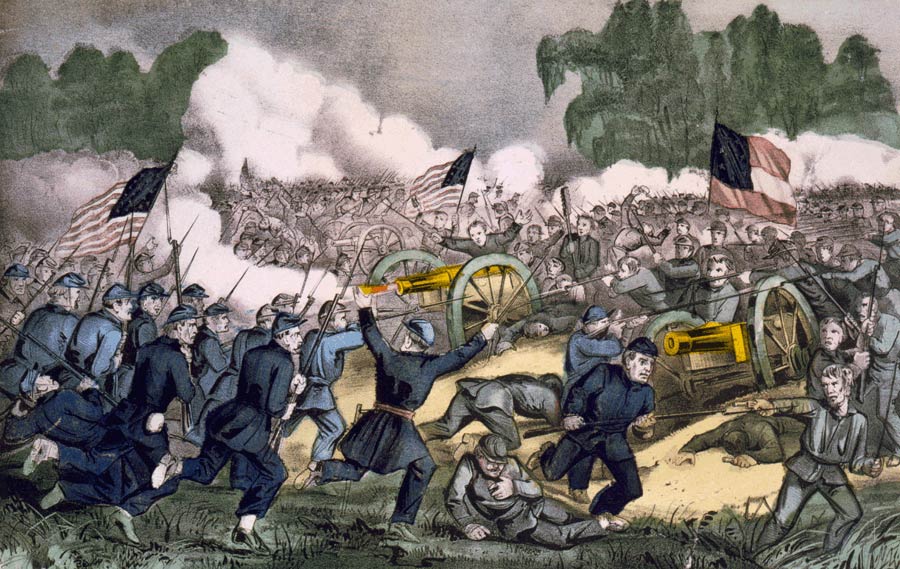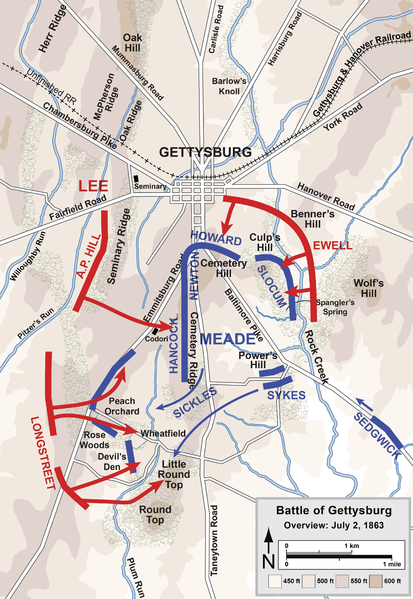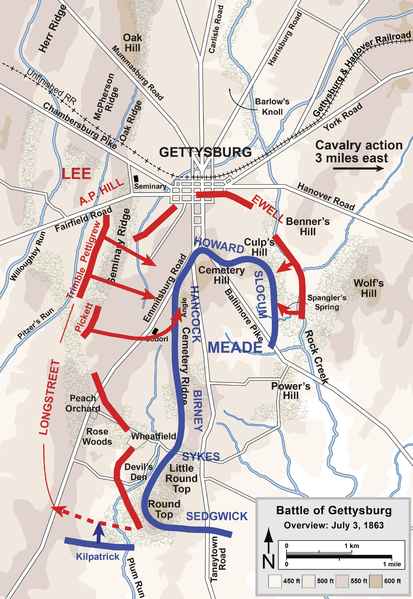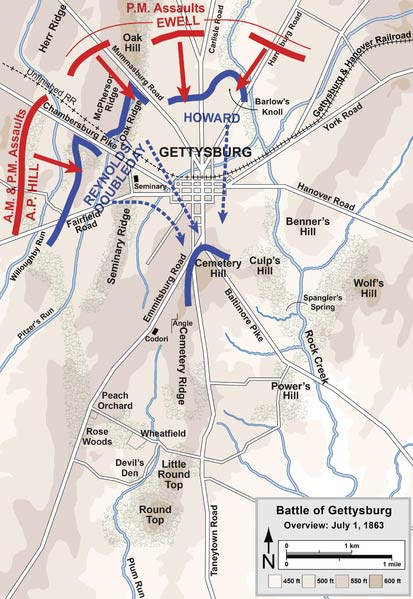| Battle of Gettysburg | |||||||
|---|---|---|---|---|---|---|---|
 |
|||||||
|
|||||||
| Contenders | |||||||
| Military Leaders | |||||||
| George G. Meade John F. Reynolds |
Robert E. Lee | ||||||
| Unit Strength | |||||||
| 93,921 | 71,699 | ||||||
| Casualties and Deaths | |||||||
| Total: 23,055 | Total: 23,231 | ||||||
|
3,155 killed 14,531 wounded 5,369 captured/missing |
4,708 killed 12,693 wounded 5,830 captured/missing |
||||||
| Part of the American Civil War | |||||||
The Battle of Gettysburg took place in and around Gettysburg town, Pennsylvania, from July 1 to July 3, 1863. This battle is considered the largest during the American Civil war, and the biggest skirmish ever fought in North America. In this battle, the Union army comprised of 85,000 men and was commanded by Major General Meade. Northern Virginia’s Confederate army, had about 75,000 men and was under the leadership of Gen. Robert E. Lee. At the end of the battle, the Union suffered approximately 23,055 casualties with 3,155 dying in the battle. The Confederacy casualties is approximately 23,231 with 4,708 killed in the battle. These losses to the South’s Army, in addition to the Confederate submission of Vicksburg in July, marked a turning point in the American Civil war.
Confederates invasion to the North
On May 1863, the Confederate army led by General Lee had scored a shattering success at Chancellorsville against the army of Potomac. After Lee’s first invasion that ended at Antietam during the previous fall, he chose to go on the offensive and raid the North for the second time. Lee’s intention was to bring the clash out of Virginia, divert the northern army from Vicksburg and get acknowledgment of the Confederacy by France and Britain and therefore reinforce the cause of northern Copperheads who wanted peace to prevail.
On the other side, President Lincoln named Major General George G. Meade to replace Gen. Joseph Hooker as the commander of the Army of Potomac. The president had lost confidence in Hooker, since he seemed reluctant to deal with Lee’s army after being defeated at Chancellorsville. General Meade ordered his men to pursue Lee’s Army immediately, though by then had already navigated through the Potomac River into Mary Land, marching on to southern Pennsylvania.
July 1: The Battle Begins
When Lee realized that the Army of the Potomac was pursuing him, he decided to assemble his troop in the flourishing junction town of Gettysburg, about 35 miles southwest of Harrisburg. Early in the morning of July 1, a Confederate division led by A.P. Hill had approached the town searching for supplies; but they found out that two Union cavalry groups had already arrived the previous day. The Confederates managed to force the outnumbered federal defenders back through town to Cemetery Hill, about half a mile to the south.
Lee was determined to push his lead before more Union army units could arrive. He ordered General Ewell, who by then was commanding the Army of Northern Virginia Second Corps after the death of General Thomas Jackson, to attack the Cemetery Hill. Ewell refused to order the raid, since he considered the Federal line to be very strong. By nightfall, a Union Corps led by Winfield Hancock had turned up and added more strength to the protective position along Cemetery Ridge to Little Round Top hill. Another three Union Corps arrived during the night, making the defenses even stronger.
July 2: Day Two of the Battle
 Early on July 2, Union Army had created a strong position from Cemetery Ridge to Culp’s Hill. Lee declined an advice from his second-in-command James Longstreet not to invade the Union position, and decided to assault the Federals at their line. He commanded Longstreet to attack from the left flank, while Ewell and his Corps were to attack from the right flank, near Culp’s Hill. The attacks were to happen in the early hours of the day, but Longstreet attacked the Union Corps led by Daniel Sickles at around 4:00 pm. Bloody fights raged along Sickle’s line over next few hours. The fight stretched from the nest of boulders called Devil’s Den, to a peach orchard, to the slopes of Little Round Top hill, and to neighboring wheat field.
Early on July 2, Union Army had created a strong position from Cemetery Ridge to Culp’s Hill. Lee declined an advice from his second-in-command James Longstreet not to invade the Union position, and decided to assault the Federals at their line. He commanded Longstreet to attack from the left flank, while Ewell and his Corps were to attack from the right flank, near Culp’s Hill. The attacks were to happen in the early hours of the day, but Longstreet attacked the Union Corps led by Daniel Sickles at around 4:00 pm. Bloody fights raged along Sickle’s line over next few hours. The fight stretched from the nest of boulders called Devil’s Den, to a peach orchard, to the slopes of Little Round Top hill, and to neighboring wheat field.
The battle left Sickles seriously injured, and the Federals lost the wheat field, orchard and the Devil’s den. Ewell’s troop had proceeded on the Union army at East Cemetery Hill and Culp’s Hill in synchronization with Longstreet’s attack. Both sides suffered great losses in day two of the battle, with each side having more than 9,000 casualties (dead, missing or injured).
July 3: The Final Day
 After fighting for 7 hours, the Union army of 12 corps forced back a Confederate threat against Culp’s Hill in the dawn of July 3. They were also able to regain their strong position. Meanwhile, Lee believed that his men had almost won the previous day, and therefore sent 3 divisions against the Union centre on Cemetery Ridge. Less than 15,000 men led by George Pickett were ordered to march across open fields and attack the buried Union infantry spots. Longstreet protested against this move, nevertheless, the attacks went forward as planned at about 3PM. Union infantry fought the advancing enemy from behind stone walls, while regiments from New York, Ohio and Vermont struck the enemy’s flanks. With these side attacks, Confederates suffered massive losses with Picket’s division losing two-thirds of its army. After the unsuccessful attack, Longstreet and Lee scrambled to support their defensive line, as the survivors staggered back to their original positions.
After fighting for 7 hours, the Union army of 12 corps forced back a Confederate threat against Culp’s Hill in the dawn of July 3. They were also able to regain their strong position. Meanwhile, Lee believed that his men had almost won the previous day, and therefore sent 3 divisions against the Union centre on Cemetery Ridge. Less than 15,000 men led by George Pickett were ordered to march across open fields and attack the buried Union infantry spots. Longstreet protested against this move, nevertheless, the attacks went forward as planned at about 3PM. Union infantry fought the advancing enemy from behind stone walls, while regiments from New York, Ohio and Vermont struck the enemy’s flanks. With these side attacks, Confederates suffered massive losses with Picket’s division losing two-thirds of its army. After the unsuccessful attack, Longstreet and Lee scrambled to support their defensive line, as the survivors staggered back to their original positions.
The Aftermath of the Battle of Gettysburg
After suffering large casualties on the third day, Lee’s hope of a successful attack to the North vanished. He waited for the Union’s counter-offensive on July 4, however that did not happen. That night, the rain fell heavily and General Lee withdrew his devastated army toward Virginia. General Meade did not pursue the rival after Gettysburg. Nonetheless, the encounter was a serious defeat to the Confederacy. Lee army suffered a casualty of around 23,000 men, which was about a third of his army. General Lee was left discouraged by the defeat, and presented his resignation to President Jefferson. The president refused the resignation and Lee continued being the commander for the rest of the war.
In conclusion, even though Lee won several other victories after this defeat, the huge number of casualties during the Battle of Gettysburg and the fact that the Confederacy had already lost at Vicksburg marked the turning point of the Civil War. Four months later after this battle, President Lincoln used a devotion ceremony for Gettysburg’s Soldiers National Cemetery, honoring the fallen Union military.
